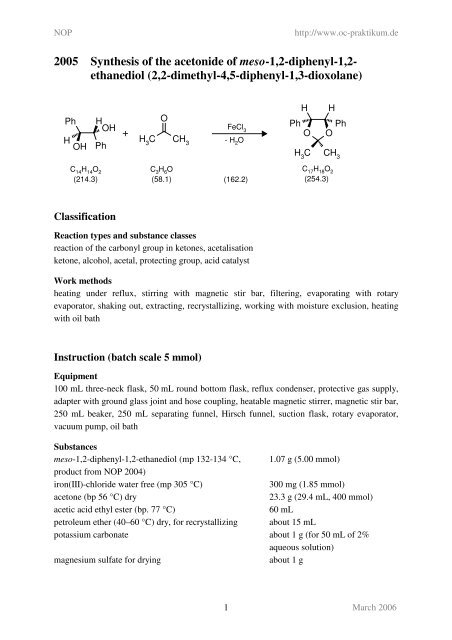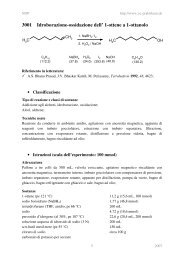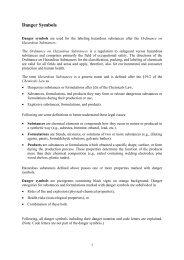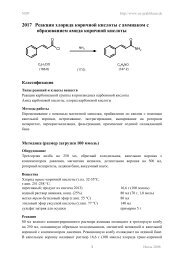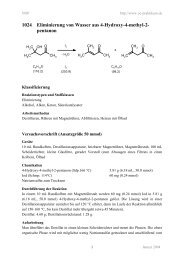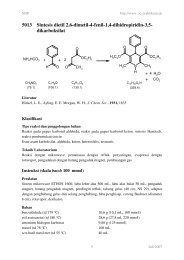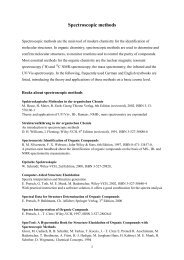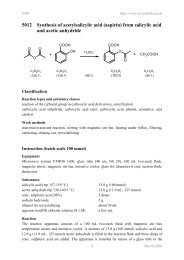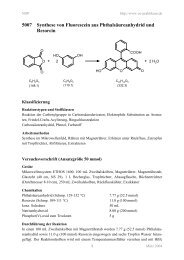2005 Synthesis of the acetonide of meso-1,2-diphenyl-1 ... - kriemhild
2005 Synthesis of the acetonide of meso-1,2-diphenyl-1 ... - kriemhild
2005 Synthesis of the acetonide of meso-1,2-diphenyl-1 ... - kriemhild
You also want an ePaper? Increase the reach of your titles
YUMPU automatically turns print PDFs into web optimized ePapers that Google loves.
NOP http://www.oc-praktikum.de<br />
<strong>2005</strong> <strong>Syn<strong>the</strong>sis</strong> <strong>of</strong> <strong>the</strong> <strong>acetonide</strong> <strong>of</strong> <strong>meso</strong>-1,2-<strong>diphenyl</strong>-1,2ethanediol<br />
(2,2-dimethyl-4,5-<strong>diphenyl</strong>-1,3-dioxolane)<br />
Ph<br />
H<br />
OH<br />
Ph<br />
C 14 H 14 O 2<br />
(214.3)<br />
H<br />
OH<br />
Classification<br />
+<br />
C<br />
H 3<br />
O<br />
C 3 H 6 O<br />
(58.1)<br />
CH 3<br />
1<br />
FeCl 3<br />
- H 2 O<br />
(162.2)<br />
Reaction types and substance classes<br />
reaction <strong>of</strong> <strong>the</strong> carbonyl group in ketones, acetalisation<br />
ketone, alcohol, acetal, protecting group, acid catalyst<br />
H<br />
Ph Ph<br />
O O<br />
C<br />
H 3<br />
H<br />
CH 3<br />
C 17 H 18 O 2<br />
(254.3)<br />
Work methods<br />
heating under reflux, stirring with magnetic stir bar, filtering, evaporating with rotary<br />
evaporator, shaking out, extracting, recrystallizing, working with moisture exclusion, heating<br />
with oil bath<br />
Instruction (batch scale 5 mmol)<br />
Equipment<br />
100 mL three-neck flask, 50 mL round bottom flask, reflux condenser, protective gas supply,<br />
adapter with ground glass joint and hose coupling, heatable magnetic stirrer, magnetic stir bar,<br />
250 mL beaker, 250 mL separating funnel, Hirsch funnel, suction flask, rotary evaporator,<br />
vacuum pump, oil bath<br />
Substances<br />
<strong>meso</strong>-1,2-<strong>diphenyl</strong>-1,2-ethanediol (mp 132-134 °C, 1.07 g (5.00 mmol)<br />
product from NOP 2004)<br />
iron(III)-chloride water free (mp 305 °C) 300 mg (1.85 mmol)<br />
acetone (bp 56 °C) dry 23.3 g (29.4 mL, 400 mmol)<br />
acetic acid ethyl ester (bp. 77 °C) 60 mL<br />
petroleum e<strong>the</strong>r (40–60 °C) dry, for recrystallizing about 15 mL<br />
potassium carbonate about 1 g (for 50 mL <strong>of</strong> 2%<br />
aqueous solution)<br />
magnesium sulfate for drying about 1 g<br />
March 2006
NOP http://www.oc-praktikum.de<br />
Reaction<br />
Since FeCl3 is very hygroscopic, only a very short contact with air is allowed.<br />
The reaction apparatus consists <strong>of</strong> a dry 100 mL three-neck flask, rinsed with nitrogen and<br />
equipped with a magnetic stir bar and a reflux condenser, which is connected with a nitrogen<br />
piping. In <strong>the</strong> reaction flask 1.07 g (5.0 mmol) 1,2-<strong>diphenyl</strong>-1,2-ethanediol are dissolved in<br />
23 g (30 mL, 400 mmol) dry acetone. 300 mg (1.85 mmol) <strong>of</strong> water free iron(III)-chloride are<br />
rapidly added, whilst <strong>the</strong> reaction mixture changes its colour to yellow-brown. It is heated<br />
under stirring for 20 minutes under reflux.<br />
Work up<br />
After cooling down to room temperature <strong>the</strong> reaction mixture is poured into a 250 mL beaker<br />
containing 50 mL <strong>of</strong> 2% potassium carbonate-solution. A brown fluffy precipitation is<br />
formed. The mixture is transferred into a 250 mL separating funnel and extracted three times<br />
with 20 mL acetic acid ethyl ester each. The organic phases are almost colourless. They are<br />
combined and again washed with 25 mL water and dried over water free magnesium sulfate.<br />
The mixture is filtered from <strong>the</strong> drying agent over a glass funnel with filter paper and <strong>the</strong><br />
solvent is removed at a rotary evaporator. The light yellow oil remaining as crude product is<br />
dried for 30 minutes at about 40 °C bath temperature with a vacuum pump at 1-2 hPa.<br />
Crude yield: 1.05 g; mp 56 °C; HPLC-purity 83%<br />
To <strong>the</strong> crude product are added 13 mL dry and pre-heated petroleum e<strong>the</strong>r (40-60 °C) in a<br />
50 mL round bottom flask and <strong>the</strong> mixture is stirred and heated for 5 minutes under reflux.<br />
Then <strong>the</strong> still hot solution is filtered <strong>of</strong>f from <strong>the</strong> insoluble residue into a 50 mL round bottom<br />
flask and <strong>the</strong> solvent is evaporated at a rotary evaporator. The remaining light yellow oily<br />
product is dried with a vacuum pump at 1-2 hPa and stored in <strong>the</strong> cooler for crystallization.<br />
Yield: 0.918 g (3.61 mmol, 72%); mp 56-57 °C<br />
The product can be recrystallized from 1 mL dry petroleum e<strong>the</strong>r (40-60 °C), however, it is<br />
still not free from educt yet.<br />
Yield: 0.52 g (2.05 mmol, 41%); mp 58-60 °C<br />
The residue (120 mg) which is insoluble in <strong>the</strong> hot petroleum e<strong>the</strong>r consists predominantly <strong>of</strong><br />
not reacted 1,2-<strong>diphenyl</strong>ethanediol.<br />
Comments<br />
The product in solid state is stable under moisture exclusion at room temperature. A solution<br />
<strong>of</strong> <strong>the</strong> product in CDCl3 shows already after one day partly cleavage into <strong>the</strong> educts, probably<br />
due to traces <strong>of</strong> acid (detection with 1 H NMR).<br />
2<br />
March 2006
NOP http://www.oc-praktikum.de<br />
Waste management<br />
Recycling<br />
The evaporated petroleum e<strong>the</strong>r is collected and redistilled.<br />
Waste disposal<br />
Waste Disposal<br />
aqueous phase from shaking out solvent water mixtures, containing halogen<br />
evaporated acetic acid ethyl ester<br />
(might contain acetone)<br />
organic solvents, halogen free<br />
Time<br />
3 hours<br />
Break<br />
After evaporation <strong>of</strong> <strong>the</strong> acetic ester<br />
Degree <strong>of</strong> difficulty<br />
Easy<br />
Analytics<br />
Reaction monitoring with HPLC<br />
Sample preparation for a batch scale <strong>of</strong> 5 mmol:<br />
For taking <strong>of</strong> each sample <strong>the</strong> oil bath is lowered. As soon as <strong>the</strong> reaction solution stops boiling, 5 mL are taken<br />
using a pipette and <strong>the</strong> sample is added to 10 mL <strong>of</strong> 2% potassium carbonate solution in a separating funnel. The<br />
solution is shaken out three times with 5 mL acetic acid ethyl ester each. The organic phases are combined and<br />
dried over water free magnesium sulfate. After filtering <strong>of</strong>f <strong>the</strong> drying agent <strong>the</strong> solvent is evaporated at a rotary<br />
evaporator. 0.5 mg from <strong>the</strong> residue are dissolved in 2 mL acetonitrile. 5 µL from this solution are injected.<br />
HPLC-conditions:<br />
colum: Phenomenex Luna C18; particle size 3 µm, length150 mm, internal diameter 4.6 mm<br />
column temperature: 25 °C<br />
injection volume: 5 µL<br />
gradient: 0 min 5% acetonitrile + 95% water<br />
40 min 95% acetonitrile + 5% water<br />
50 min 95% acetonitrile + 5% water<br />
flow: 1.0 mL/min<br />
wave length: 220 nm<br />
Samples taken after 10, 20, 30, 40 and 60 minutes reaction time showed in <strong>the</strong> HPLC all <strong>the</strong> same ratio <strong>of</strong><br />
product to educt: 95% <strong>acetonide</strong> and 5% 1,2-<strong>diphenyl</strong>ethanediol.<br />
3<br />
March 2006
NOP http://www.oc-praktikum.de<br />
HPLC <strong>of</strong> <strong>the</strong> crude product<br />
Sample preparation:<br />
0.5 mg substance are dissolved in 2 mL acetonitrile, from this solution 5 µL are injected.<br />
mAU<br />
800<br />
600<br />
400<br />
200<br />
0<br />
0 10 20 30 40 50<br />
HPLC <strong>of</strong> <strong>the</strong> pure product<br />
(After recrystallization)<br />
Sample preparation as discribed for <strong>the</strong> crude product<br />
mAU<br />
800<br />
600<br />
400<br />
200<br />
0<br />
16.835<br />
16.829<br />
0 10 20 30 40 50<br />
30.947<br />
30.938<br />
Retention time (min) Substance<br />
Peak area %<br />
Crude product Pure product<br />
16.8 1,2-<strong>diphenyl</strong>-1,2-ethanediol (educt) 2.5 2.8<br />
30.9 <strong>acetonide</strong> (product) 82.9 96.1<br />
o<strong>the</strong>rs not identified 14.4 1.1<br />
4<br />
min<br />
min<br />
March 2006
NOP http://www.oc-praktikum.de<br />
1 H NMR spectrum <strong>of</strong> <strong>the</strong> crude product (400 MHz, CDCl3)<br />
7.0<br />
6.0<br />
5.0<br />
4.0<br />
(ppm)<br />
3.0<br />
2.0<br />
From <strong>the</strong> intensities <strong>of</strong> <strong>the</strong> two singuletts at 5.53 and 4.83 ppm results a ratio <strong>acetonide</strong> to <strong>diphenyl</strong>ethanediol<br />
96 : 4. The fact, that <strong>the</strong> methyl groups show clearly different chemical shifts, proves <strong>the</strong> stereochemistry <strong>of</strong> <strong>the</strong><br />
used diol: The <strong>acetonide</strong> <strong>of</strong> <strong>the</strong> <strong>meso</strong>-isomer has both phenyl groups at <strong>the</strong> same side <strong>of</strong> <strong>the</strong> five membered ring,<br />
so that <strong>the</strong> two mehtyl groups have a very different environment.<br />
1 H NMR spectrum <strong>of</strong> <strong>the</strong> pure product (300 MHz, CDCl3)<br />
(After recrystallization)<br />
7.0<br />
6.0<br />
5.0<br />
4.0<br />
(ppm)<br />
δ (ppm) Multiplicity Number <strong>of</strong> H Assignment<br />
7.4-7.2 M CH arene (educt)<br />
7.2-6.8 M 10 CH arene (product)<br />
5.53 S 2 CH – O – (product)<br />
4.84 s CH – O – (educt)<br />
1.84 s 3 CH3<br />
1.62 s 3 CH3<br />
7.26 s solvent<br />
3.0<br />
2.0<br />
5<br />
1.0<br />
1.0<br />
0.0<br />
0.0<br />
ratio<br />
<strong>acetonide</strong> : diol:<br />
98 : 2<br />
March 2006
NOP http://www.oc-praktikum.de<br />
1 H NMR spectrum <strong>of</strong> <strong>the</strong> crude product (300 MHz, CDCl3)<br />
(After <strong>the</strong> solution was stored for 2 days)<br />
7.0<br />
6.0<br />
5.0<br />
4.0<br />
(ppm)<br />
Obviously <strong>the</strong> signals from 1,2-<strong>diphenyl</strong>ethanediol increased a bit, fur<strong>the</strong>rmore<br />
<strong>the</strong>re is an additional singulett at 2.17 ppm from acetone.<br />
1 H NMR spectrum <strong>of</strong> <strong>the</strong> flask residue (300 MHz, CDCl3)<br />
(After <strong>the</strong> hot filtration)<br />
7<br />
6<br />
5<br />
4<br />
(ppm)<br />
3.0<br />
3<br />
Here <strong>the</strong> signals from 1,2-<strong>diphenyl</strong>ethanediol are significantly stronger than those from <strong>the</strong> product.<br />
(The broad singulett at 1.95 ppm originates from <strong>the</strong> OH-protons <strong>of</strong> <strong>the</strong> diol.)<br />
2.0<br />
2<br />
6<br />
1.0<br />
1<br />
0.0<br />
0<br />
March 2006
NOP http://www.oc-praktikum.de<br />
13 C NMR spectrum <strong>of</strong> <strong>the</strong> pure product (300 MHz, CDCl3)<br />
140<br />
130<br />
120<br />
110<br />
100<br />
90<br />
80<br />
(ppm)<br />
δ (ppm) Assignment<br />
137.7 Cquart arene<br />
128.3 - 126.9 CH arene<br />
108.8 – O – C – O –<br />
81.5 CH – O –<br />
26.8 CH3<br />
24.5 CH3<br />
76.5-77.5 solvent<br />
70<br />
60<br />
7<br />
50<br />
40<br />
30<br />
20<br />
March 2006
NOP http://www.oc-praktikum.de<br />
IR spectrum <strong>of</strong> <strong>the</strong> crude product (KBr)<br />
Transmission [%]<br />
80<br />
70<br />
60<br />
50<br />
40<br />
30<br />
20<br />
4000 3500 3000 2500 2000 1500 1000 500<br />
Wellenzahl [cm -1 ]<br />
IR spectrum <strong>of</strong> <strong>the</strong> pure product (KBr)<br />
Transmission [%]<br />
80<br />
70<br />
60<br />
50<br />
40<br />
30<br />
20<br />
10<br />
0<br />
4000 3500 3000 2500 2000 1500 1000 500<br />
Wellenzahl [cm -1 ]<br />
(cm -1 ) Assignment<br />
3095-3000 C – H – valence, arene<br />
2990-2880 C – H – valence, alkane<br />
1490, 1454 C = C – valence, arene<br />
8<br />
March 2006


